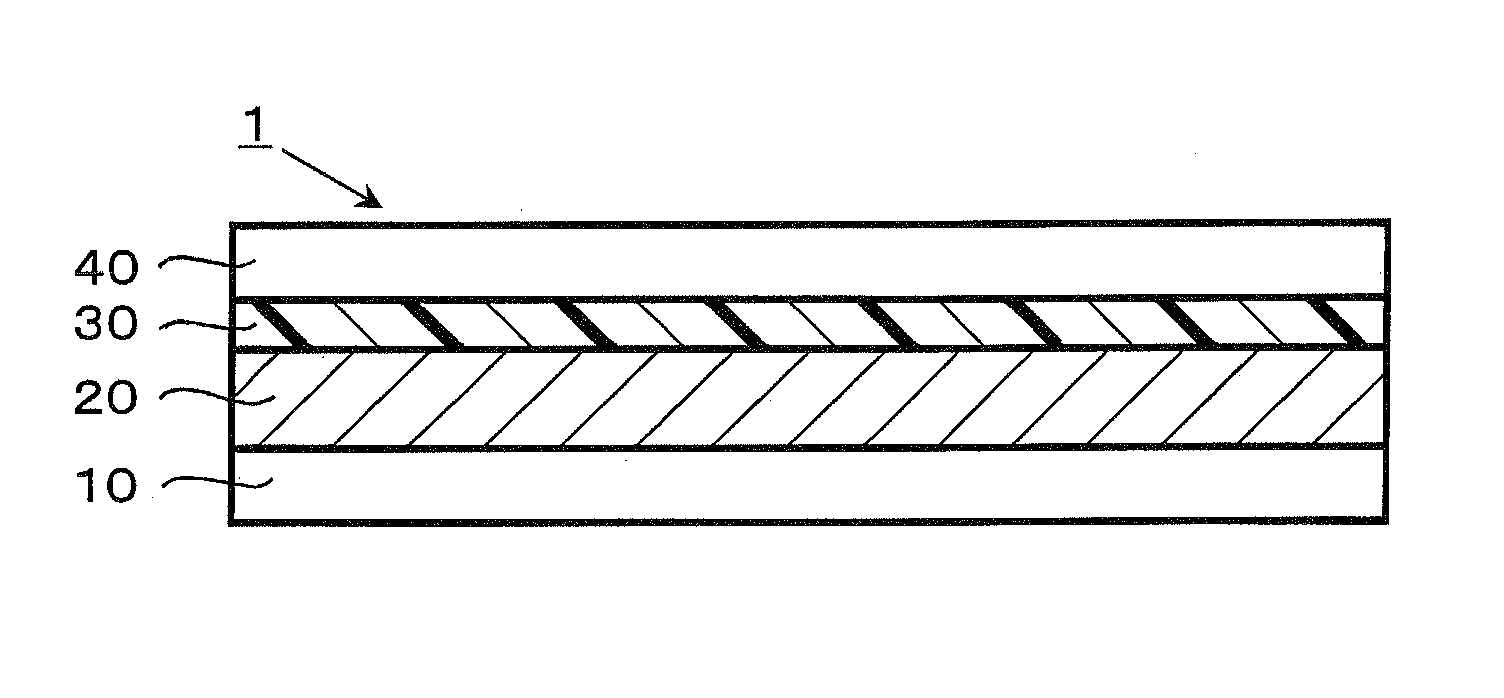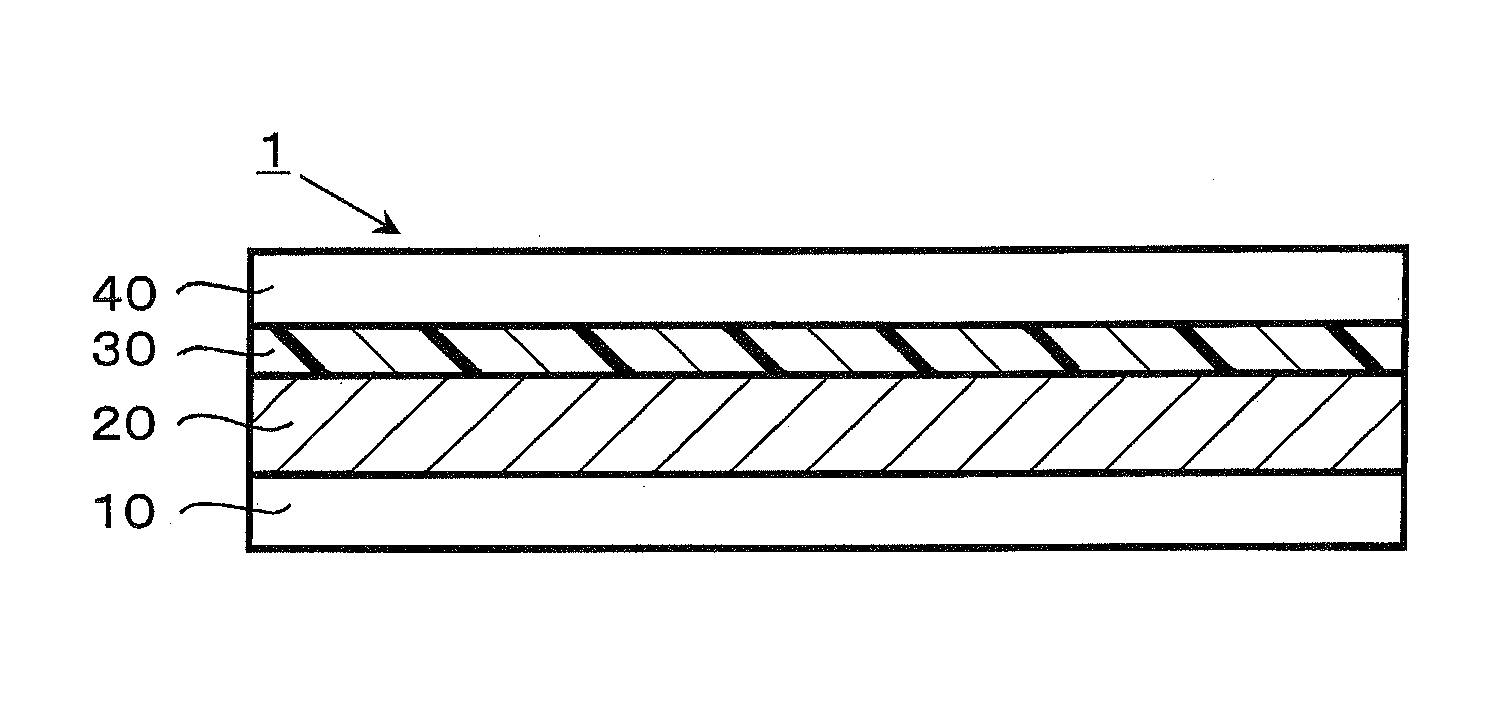Dye-sensitized solar cell, dye-sensitized solar cell module, and coating liquid for forming electrolyte layer
a solar cell and solar cell technology, applied in the direction of electrolytic capacitors, pv power plants, capacitors, etc., can solve the problems of reducing photoelectric conversion efficiency, risk of liquid leakage from the electrolyte layer, and serious environmental issues, so as to improve the compatibility and absorption of electrolyte solution, the effect of reducing the production cost of dye-sensitized solar cells
- Summary
- Abstract
- Description
- Claims
- Application Information
AI Technical Summary
Benefits of technology
Problems solved by technology
Method used
Image
Examples
example 1
[0083]An electrolyte solution was prepared by dissolving hexylmethylimidazolium iodide (Tomiyama Pure Chemical Industries, Ltd.) (6 mol / l), iodine (Merck) (0.6 mol / l), N-methylbenzimidazole (Aldrich) (0.45 mol / l), and guanidium thiocyanate (Aldrich) (0.1 mol / l) in ethylmethylimidazoliumthiocyanate (Merck).
[0084]Subsequently, a resin solution was prepared by dissolving cationic hydroxy ethylcellulose (Daicel Corporation; m=1.3; cationization percentage: 35% of —CH2CH2OH groups) cationized with 3-chloro-2-hydroxy propyltrimethyl ammonium chloride in pure water so as to result in a cationic hydroxy ethylcellulose concentration of 5% by weight.
[0085]Then, the above electrolyte solution and the above resin solution were mixed at a weight ratio of 1:6. The mixture was sufficiently kneeded. Thus, a coating liquid A for forming an electrolyte layer was obtained.
[0086]Next, Ti Nanoxide D / SP (Solaronix; a paste containing titanium oxide at approximately 20% by weight) was applied to a fluorin...
example 2
[0090]A coating liquid B for forming an electrolyte layer was prepared in the manner used in Example 1 except that glycidyltrimethyl ammonium chloride was used as the cationization agent. The coating liquid B was applied to a porous semiconductor layer, followed by drying. Thus, a solid electrolyte layer was formed. Then, the solid electrolyte layer was combined with a counter electrode such that a dye-sensitized solar cell was produced.
example 3
[0091]A coating liquid C for forming an electrolyte layer was prepared in the manner used in Example 1 except that hydroxy propylmethylcellulose was used as the cellulose to be cationized or a derivative thereof. The coating liquid C was applied to a porous semiconductor layer, followed by drying. Thus, a solid electrolyte layer was formed. Then, the solid electrolyte layer was combined with a counter electrode such that a dye-sensitized solar cell was produced.
[0092]In this Example, a method for producing cationic hydroxy propylmethylcellulose is described as follows. First, hydroxy propylmethylcellulose (Shin-Etsu Chemical Co., Ltd.; 90SH-15,000; M.S. (degree of substituion of 3 OH groups of cellulose) for a hydroxy propyl group: 0.17; M.S. for a methyl group: 1.48; the viscosity of a 2% aqueous solution at 20° C.: 13,300 mPa·s) (200 g) was added to a reaction flask provided with a stirrer and a condenser. Then, t-butanol (2,000 g) was added thereto, followed by stirring for dispe...
PUM
| Property | Measurement | Unit |
|---|---|---|
| temperatures | aaaaa | aaaaa |
| temperature | aaaaa | aaaaa |
| thickness | aaaaa | aaaaa |
Abstract
Description
Claims
Application Information
 Login to View More
Login to View More - R&D
- Intellectual Property
- Life Sciences
- Materials
- Tech Scout
- Unparalleled Data Quality
- Higher Quality Content
- 60% Fewer Hallucinations
Browse by: Latest US Patents, China's latest patents, Technical Efficacy Thesaurus, Application Domain, Technology Topic, Popular Technical Reports.
© 2025 PatSnap. All rights reserved.Legal|Privacy policy|Modern Slavery Act Transparency Statement|Sitemap|About US| Contact US: help@patsnap.com


